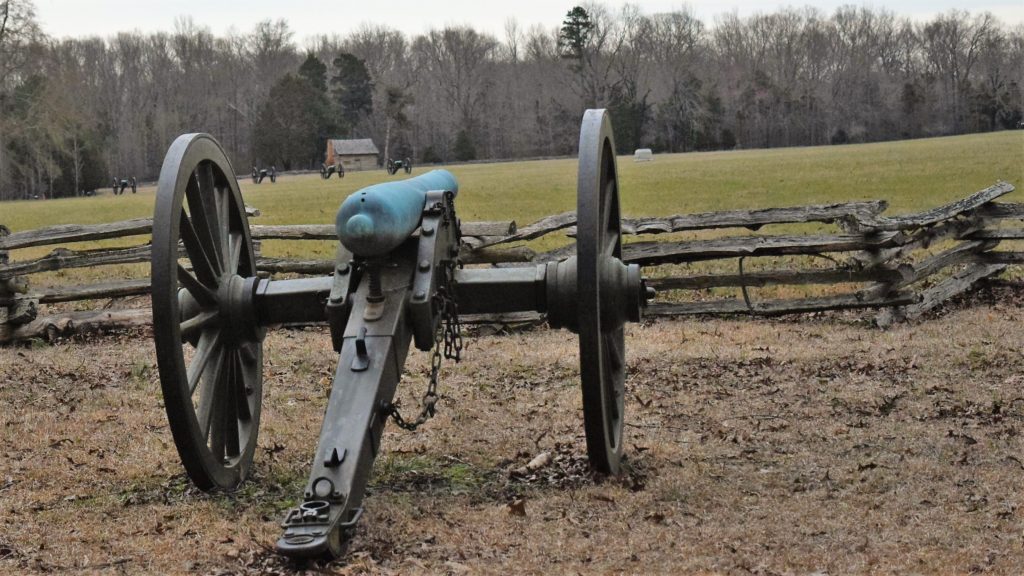About halfway between Memphis and Nashville, about 2 hours from each, lies one of the most sobering battlefields of the Civil War. This was the first major battle of the Civil war, occurring in April 1862. To put this battle in perspective, consider that there were about 36,000 American casualties (dead and wounded) in the 8 year war for America’s independence. At Shiloh, there were 26,000 killed or wounded in a matter of only two days.
Before the war ended, there would be a 5 other battles with more casualties (Gettysburg, Spotsylvania Court House, Chickamauga, the Wilderness, and Antietam). But Shiloh, which is named for the small country church around which the battle raged, is one of the most impressive to visit, because the park preserves the battlefield exactly as it was during the war, i.e., forests then are forests now, same with fields, and cannon and markers show exactly where everything happened.
The day starts with an excellent historical reenactment film describing the battle. It was a tale of two days: the Confederates won the first day, sending a note to Jefferson Davis saying they had achieved complete victory. They had broken through the Union center, captured the forces there, and divided the northern army into two fragments. But overnight, reinforcements arrived for the Union. Then the commanding general for the South would die from a stray bullet, leading to a Union victory the second day and Confederate retreat.
In the end, the battle was a draw, as neither side achieved its mission. Grant, the Union general, was trying to take the Corinth train station, deep in the South. By doing so, he would cut off all supplies moving both east-west and north-south. But dividing the south into four parts, with control of the center, he hoped to force an early surrender and end the war quickly with a knockout blow.
Johnstone, the Confederate general, sought to surprise Grant before all his troops arrived and force him to surrender his entire army. He turned out to be one day short of doing that, and died in the battle. He remains, to this day, the highest-ranking American killed in wartime.
Conversely, by the end, things were as they started. The Confederates were able to stop Grant short of Corinth. Without ongoing supplies, he would have to pull back. But in doing so, the Federal forces were able to keep their army intact to fight (and eventually win) another day.
What is unusual about this battlefield is that so much of the fighting takes place in very thick forest, not in open fields. The key point in the center was a densely wooded section called the Hornet’s Nest. Ensconced within it, Union soldiers were able to repel wave after wave of the enemy until the Confederates brought in the heavy artillery.
Here then, are my ten pictures of Shiloh National Military Park.

This is a re-creation of the original Shiloh church, destroyed during the battle. 
There are dozens of monuments to state regiments, like this imposing one to a company from Iowa. 
If you like historic cannon of every type, this is the place for you. 
One of the 20 tour stops. Most are like this, a combination of memorial markers and cannon. 
I have many more classis cannon pictures like this one, which sort of epitomizes the image of a battle forest instead of a battlefield. 
This is the famous Hornet’s nest. Imagine fighting in here in April, when all the trees had leaves. 
Cannons aimed at open field like this are rare. 
And natural pathways like this are also rare. 
Yankees, with control of the battlefield at the end, buried Confederates in mass graves such as this one. 
The description of the Confederate monument, depicting defeat and loss after initial victory. Click on the picture for more details.
SHILOH
A Requiem (April 1862)
Herman Melville
Skimming lightly, wheeling still,
The swallows fly low
Over the field in clouded days,
The forest-field of Shiloh–
Over the field where April rain
Solaced the parched ones stretched in pain
Through the pause of night
That followed the Sunday fight
Around the church of Shiloh–
The church so lone, the log-built one,
That echoed to many a parting groan
And natural prayer
Of dying foemen mingled there–
Foemen at morn, but friends at eve–
Fame or country least their care:
(What like a bullet can undeceive!)
But now they lie low,
While over them the swallows skim,
And all is hushed at Shiloh.